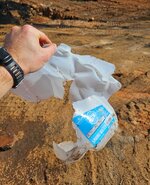@polishmanmike if you search this site you will find a ton of information on how bullets work, and what various types of bullets do differently from each other. Some pass it off as mental masturbation, but it does help you set a realistic expectation when choosing a bullet.
Basically your expectation was wrong. Copper monos even when they work perfectly, create a SMALLER wound than most lead bullets, and a MUCH smaller wound than a fragmenting lead bullet. I shoot copper because I am specifically looking for minimum meat loss. People who prefer maximum wound size consider copper bullets inferior and gravitate to frangible lead. Generally I will always see a caliber sized entry, and a golf-ball sized exit, but it will vary depending on if you hit any bone and especially on impact velocity. With a lower velocity impact in copper I have never seen a wound anywhere remotely close to what you described as your expectation—a big, gaping hole is what you might expect from a fragmenting lead bullet, but not from a copper mono. If you hit high lungs and no ribs you are basically just punching a .60” hole through the lungs—its not so different than an arrow, so expect them to sometimes run as if they’d been arrowed. High lung hits, especially at lower velocity, often dont bleed much either. Folks on this site are often western-focused so may not always be used to the lower-velocity offerings, and generally folks using copper tend toward high or extremely high velocity cartridges to ensure those bullets upset.
Call barnes and ask them what their recommended minimum expansion velocity is for that specific bullet—the answer is NOT the same across the board for all .308 TTSX or TSX bullets. They do make bullets designed to expand at much lower velocities, example their muzzleloader bullets—its likely your bullet is one such bullet. Add at least 10% to what they tell you to give yourself wiggle room, as “minimum” is barely larger than caliber diameter. Use a ballistic calculator to determine what range the bullet falls below that velocity, and consider that your maximum range (if its less than your existing max range—it could be).
Basically your expectation was wrong. Copper monos even when they work perfectly, create a SMALLER wound than most lead bullets, and a MUCH smaller wound than a fragmenting lead bullet. I shoot copper because I am specifically looking for minimum meat loss. People who prefer maximum wound size consider copper bullets inferior and gravitate to frangible lead. Generally I will always see a caliber sized entry, and a golf-ball sized exit, but it will vary depending on if you hit any bone and especially on impact velocity. With a lower velocity impact in copper I have never seen a wound anywhere remotely close to what you described as your expectation—a big, gaping hole is what you might expect from a fragmenting lead bullet, but not from a copper mono. If you hit high lungs and no ribs you are basically just punching a .60” hole through the lungs—its not so different than an arrow, so expect them to sometimes run as if they’d been arrowed. High lung hits, especially at lower velocity, often dont bleed much either. Folks on this site are often western-focused so may not always be used to the lower-velocity offerings, and generally folks using copper tend toward high or extremely high velocity cartridges to ensure those bullets upset.
Call barnes and ask them what their recommended minimum expansion velocity is for that specific bullet—the answer is NOT the same across the board for all .308 TTSX or TSX bullets. They do make bullets designed to expand at much lower velocities, example their muzzleloader bullets—its likely your bullet is one such bullet. Add at least 10% to what they tell you to give yourself wiggle room, as “minimum” is barely larger than caliber diameter. Use a ballistic calculator to determine what range the bullet falls below that velocity, and consider that your maximum range (if its less than your existing max range—it could be).


